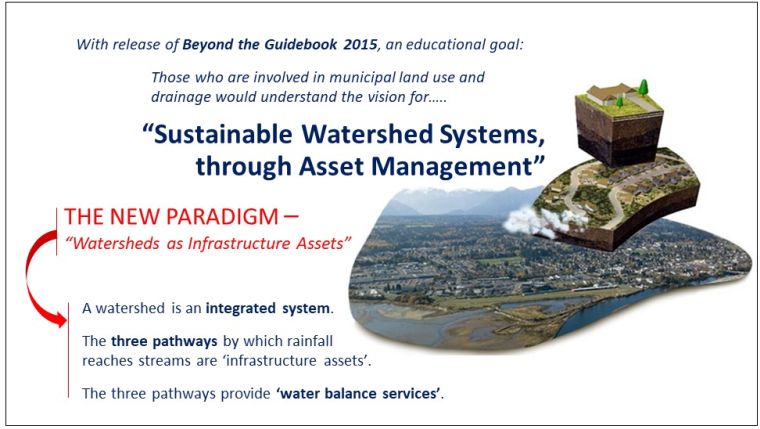DOWNLOADABLE RESOURCE: Assessing the Worth of Ecological Services Using the Ecological Accounting Process (EAP) for Watershed Assessment (released at the Nanaimo Water Stewardship Symposium, April 2018)
Note to Reader:
Funded by the governments of Canada and BC, the capacity-building program branded as Sustainable Watershed Systems, through Asset Management is designed to inform and educate local governments and stakeholders about the whole-system, water balance approach.
The program includes the Ecological Accounting Process (EAP) to value the ‘water balance services’ provided by nature. Demonstration applications for small watersheds in the Cowichan and Comox valleys have been undertaken to show how local governments would apply this unique approach.

EAP and the Water Balance Methodology are Interconnected
The Nanaimo Water Stewardship Symposium on April 11-12, 2018 was designed to foster a conversation in the mid-Vancouver Island region and beyond about the transformational scope of the “Sustainable Watershed Systems, through Asset Management” program.
“A vision for restorative development that revitalizes watershed function and health provided a philosophical backdrop for the Nanaimo Water Stewardship Symposium, co-hosted by the Partnership for Water Sustainability in British Columbia and the Nanaimo and Area Land Trust (NALT),” stated Kim Stephens, Partnership Executive Director.
Restorative Development
“The term ‘restorative development’ was coined by the writer Storm Cunningham in his first book The Restoration Economy, published in 2002,” contined Kim Stephens. It was the first book to document the new disciplines and fast-growing industries that are renewing our natural, built, and socioeconomic environments.
 “The Symposium provided a platform for a call for action because adapting to climate change requires transformation in how we value nature and service land. An informed stewardship sector can be a catalyst for action on Vancouver Island and beyond, through collaboration with local government.
“The Symposium provided a platform for a call for action because adapting to climate change requires transformation in how we value nature and service land. An informed stewardship sector can be a catalyst for action on Vancouver Island and beyond, through collaboration with local government.
“Tim Pringle shared demonstration application anecdotes about the Ecological Accounting Process (EAP), a whole-system view of watersheds that assesses hydrology in order to accurately describe ecological services.”
Why EAP is Useful
“The focus of EAP is on watershed hydrological conditions and the dependent ecological services provided, and which sustain natural systems and human settlement. EAP is not about engineering practices as the analytical starting point. Neither is it about managing hydrology through a land use, transportation, or other human settlement framework (or lens),” explained Tim Pringle, Chair, EAP Initiative.
 “The goal of EAP is to establish what the definable benefits of ecological services derived from watershed hydrology are, what they may be worth to stakeholders, and how they may be maintained and enhanced to function in near optimal condition. This goal is completely compatible with official plans.
“The goal of EAP is to establish what the definable benefits of ecological services derived from watershed hydrology are, what they may be worth to stakeholders, and how they may be maintained and enhanced to function in near optimal condition. This goal is completely compatible with official plans.
“Suffice to say, we have taken the concept of Sustainable Watershed Systems; through Asset Management, and we have made it real. We have applied the Water Balance Methodology because it provides an accurate analysis of the condition of the hydrology. And in so doing, we have connected the dots. A defining statement is that the worth of a creekshed is a package of ecological services made possible by the hydrology.
“The Cowichan and Comox demonstration applications allow us to be unequivocal in stating that ‘hydrology is the engine that powers ecological services’,” concluded Tim Pringle.
To Learn More:
To download a copy of the booklet that was released at the Nanaimo Water Stewardship Symposium in April 2018, click on Assessing the Worth of Ecological Services Using the Ecological Accounting Process (EAP) for Watershed Assessment
For information about the program design for the Nanaimo Water Symposium, visit the homepage at: https://waterbucket.ca/viw/category/convening-for-action-in-2018/nanaimo-water-symposium/


